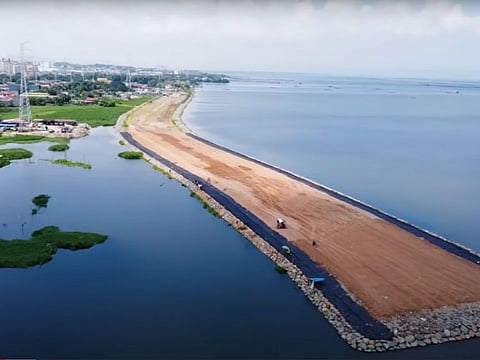Manila: $804-million C6 Expressway along Laguna Bay in the works
32.6-km expressway along country's largest lake seen easing congestion in the capital

Manila: The long-awaited C6 Expressway, or Southeast Metro Manila Expressway Project (SEMME), is inching closer to reality.
With right-of-way (ROW) procedures nearing completion, construction on this vital lakeshore road is in progress. The project runs in part on reclaimed land from Laguna Bay, with some elevated sections, potentially offering a much-needed solution to the capital's crippling traffic congestion.
The under-construction lakeshore motorway will run alongside the mouth of Laguna Bay, the country's largest freshwater lake (area 911.7 sq km).
Length: 32.66km
The six-lane toll road project will have an approximate length of 32.66 km.
Laguna de Bay, also known as Laguna Lake and alternatively spelled "Laguna de Bae", is located southeast of Metro Manila, between the provinces of Laguna to the south and Rizal to the north.
Once completed, C6 will have a commulative length of 195,000 metres, equivalent to 39,192 cars arranged end-to-end. That's just one-sixth of car sales in the first half of 2024, when total auto sales in the country logged 228,753 units, up 10.1 per cent from the same period last year.
Metro Manila has led all the regions in the vehicle fleet with a 38.61 per cent share of the total passenger vehicles, according to Philippine Statistics Authority data in 2017.
Government data shows Metro Manila has led all the regions in the vehicle fleet with a 38.61 per cent share of the total passenger vehicles
Concessionaire
The 30-year concession project was awarded to Citra Intercity Tollways Incorporated (CITI) and will be operated by Metro O&M Corp.
On the government side, the project will be implemented by the Philippine National Construction Corporation (PNCC) and the Toll Regulatory Board under a supplemental toll operation agreement, as noted by the PPP Centre.
Civil works are currently in progress. The PPP Centre has reported 100-per cent completion of the construction of the P61-P66 viaduct for Section 1B, while test pitting at Pier 00 in Arca South and Piers 71 and 72 along C5 Road in Taguig is ongoing.
The centre is also awaiting the finalisation of revised Detailed Engineering Design (DED) drawings for Section 1A and Section 2 realignment.
Additionally, Right-of-Way Acquisition (ROWA) activities are ongoing for Section 1B.
Cost
As a private-public partnership project (PPP), C6 had an estimated project cost (at the time of approval) at 35.50 billion pesos, though another estimate was given at 45.29 billion pesos ($804 million).
Designed as a six-lane major thoroughfare, C6 is aimed to alleviate traffic congestion and improve connectivity in the southern part of the city.
Right-of-way (ROW)
According to the latest report from the Department of Public Works and Highways (DPWH), 134 Agreement to Demolish and Remove Improvement (ADRI) documents had been submitted to the agency; there 122 has already been signed by the claimants; while 130 were already with Advances and Reimbursement Agreement (ARA).
In terms of lots, there are 77 Deed of Absolute Sale (DOAS) documents, all of which were already prepared, 63 have already been signed by the claimants and 27 were already with ARA.
What to know about Manila's C6 Expressway:
Route:
It will connect from existing skyway at FTI in Taguig City, run along C5/Diego Silang towards existing C6 in Taguig City, continue along Laguna Lake, then link to Ortigas Avenue extension, cross Sumulong Highway, towards Marcos Highway to Tumana Bridge at San Mateo, Rizal and terminate to Batasan Complex at Quezon City.
The C6 toll road would eventually extend to pass through Parañaque, Las Piñas, Muntinlupa, and Pateros, all the way to Calamba.
Purpose:
The main purpose of the C6 road is to provide an alternative route to the busy EDSA and South Luzon Expressway, reducing traffic congestion and improving travel times for commuters.
Sections:
The C6 road is divided into several segments, each with its own characteristics and features. Some sections are elevated, while others are at ground level.
Toll:
The C6 road is a toll road, meaning that motorists are required to pay a fee to use the expressway. The toll rates vary depending on the distance traveled.
Intersections:
The planned expressway intersects with several other major roads in Metro Manila, including the EDSA, C5, and SLEX. These intersections can be busy during peak hours, so it's important to plan your route accordingly.
Development:
The toll road project is still under construction in some areas, and there may be traffic restrictions or detours in place. It's advisable to check for updates and road closures before traveling on the C6 road.
Overview:
Length: Approximately 32.664 km
Configuration: Combination of elevated and at-grade sections
Lanes: 6 lanes (2 x 3)
Design Speed: Expressway 80 kph, Rampway: 40 kph
Ramps: 28 ramps
Route: From SLEX Skyway (FTI) to Batasan Complex (Quezon City)
Structures: 134 ADRI documents, 122 signed, 130 with Advances and Reimbursement Agreement (ARA).
Lots: 77 DOAS documents, 63 signed, 27 with ARA.
Updates:
Section 1: ROW budget request submitted for General Appropriations Act (GAA) FY 2025.
Section 2: Preparation ongoing.
Section 3: Structural mapping and reclamation cost estimate (RCEs) preparation ongoing.
Sections 4-6: Project endorsement secured from local government units (LGUs), ROW markings requested to the Toll Regulatory Board (TRB).
Civil Works:
Section 1: Construction on workable areas at C5 (Piers 61 to 66) completed.
Concessionaire: Citra Intercity Tollways Inc. (CITI)
Project Cost: Php 31.32 Billion (Based on Basic Design), Php 45.29 Billion (as per IC Estimate)
Sign up for the Daily Briefing
Get the latest news and updates straight to your inbox



